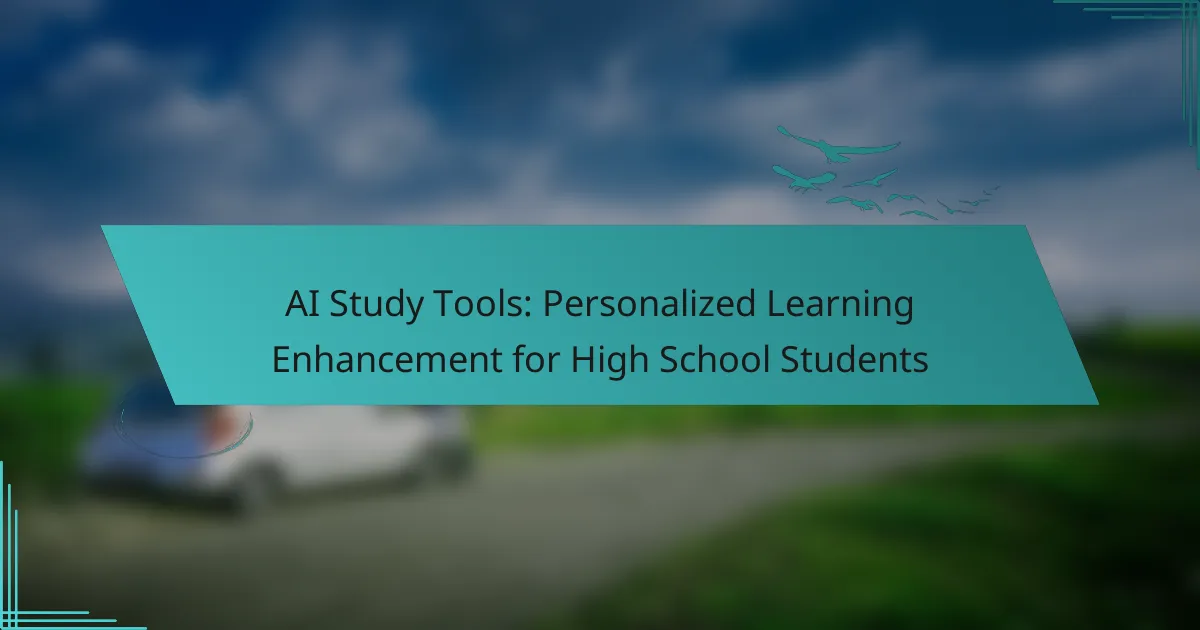AI study tools are revolutionizing the educational landscape for high school students by providing personalized learning experiences that cater to individual needs and preferences. By leveraging data, these tools adapt content and pacing, offering tailored resources and real-time feedback that enhance understanding and retention of complex subjects.
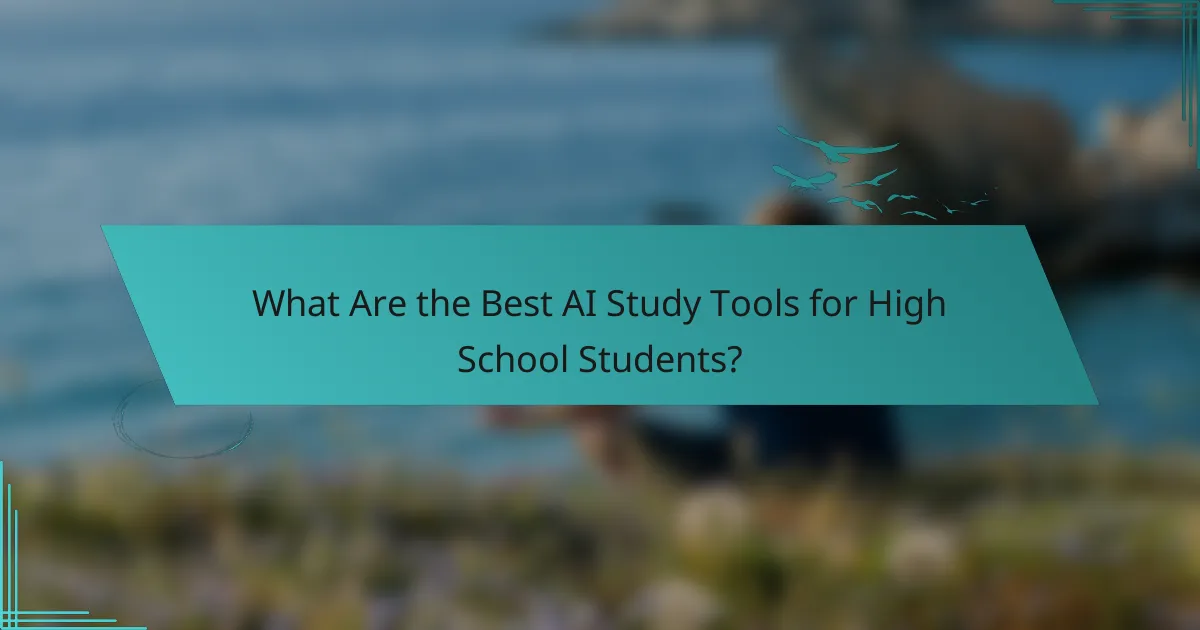
What Are the Best AI Study Tools for High School Students?
The best AI study tools for high school students enhance personalized learning experiences, helping them grasp complex subjects more effectively. These tools offer tailored resources, interactive exercises, and real-time feedback to support students’ unique learning needs.
Khan Academy
Khan Academy is a free online platform that provides a vast array of instructional videos, practice exercises, and a personalized learning dashboard. Students can learn at their own pace, receiving immediate feedback on their progress.
The platform covers subjects like math, science, and humanities, making it suitable for a diverse range of high school curricula. Students can set specific goals and track their achievements over time, which fosters motivation and accountability.
Quizlet
Quizlet is an interactive study tool that allows students to create and share flashcards, quizzes, and games. It uses AI to suggest study sets based on individual learning habits, making it easier to focus on challenging topics.
With features like “Learn” mode and “Match” games, students can engage with material in various ways. This versatility helps reinforce knowledge retention and makes studying more enjoyable.
Duolingo
Duolingo is an AI-driven language learning app that offers bite-sized lessons in multiple languages. It adapts to the user’s skill level, providing personalized exercises that help improve vocabulary and grammar.
Students can practice speaking, listening, reading, and writing through gamified lessons, which keeps them motivated. The app’s social features allow learners to connect with peers, enhancing collaborative learning experiences.
Grammarly
Grammarly is an AI-powered writing assistant that helps students improve their writing skills by providing real-time grammar, punctuation, and style suggestions. It can be integrated into various platforms, including word processors and email clients.
This tool is particularly useful for high school students working on essays and research papers, as it helps them refine their writing and avoid common mistakes. The premium version offers advanced feedback on tone and clarity, further enhancing writing quality.
Edmodo
Edmodo is an educational platform that facilitates communication between teachers and students. It allows for the sharing of resources, assignments, and feedback in a secure environment, promoting collaboration and engagement.
Students can join groups based on their classes and access materials shared by their teachers. This tool also supports quizzes and polls, enabling educators to gauge student understanding and adapt their teaching strategies accordingly.
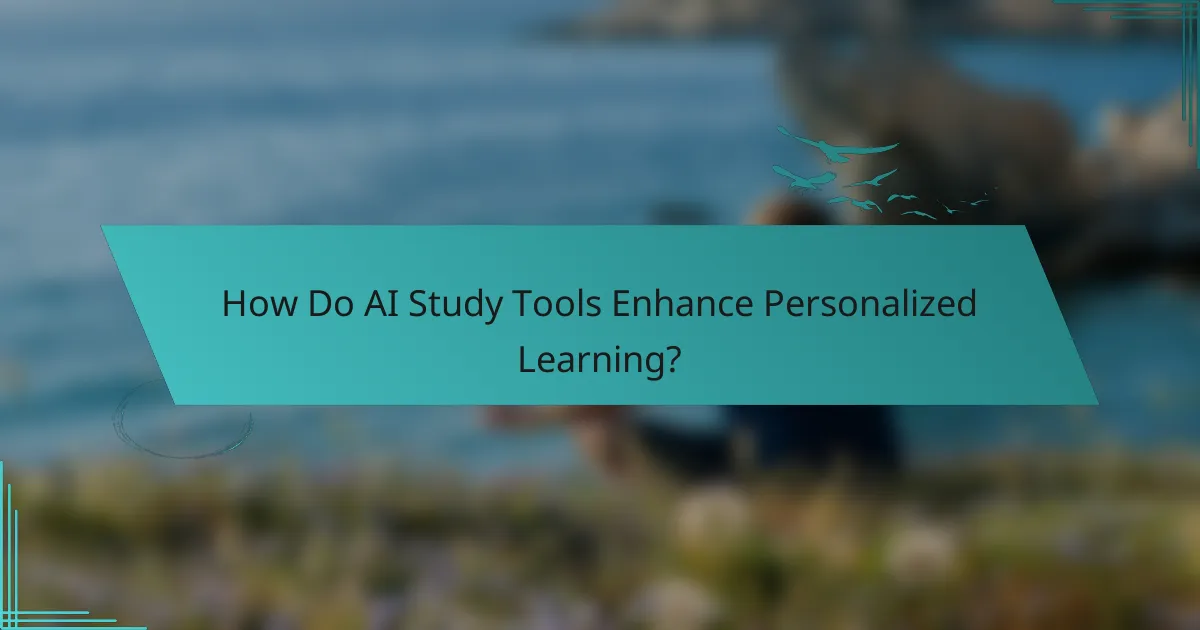
How Do AI Study Tools Enhance Personalized Learning?
AI study tools enhance personalized learning by tailoring educational experiences to individual student needs, preferences, and learning styles. These tools leverage data to adapt content, pacing, and feedback, making learning more effective and engaging for high school students.
Adaptive Learning Algorithms
Adaptive learning algorithms analyze student performance in real-time to adjust the difficulty and type of content presented. By identifying areas where a student struggles or excels, these algorithms can modify lessons to ensure optimal challenge levels, promoting better retention and understanding.
For example, if a student consistently finds algebra problems too easy, the algorithm may introduce more complex equations or related concepts. This dynamic adjustment helps maintain engagement and encourages mastery of subjects.
Customized Study Plans
Customized study plans are developed based on a student’s unique learning profile, including strengths, weaknesses, and interests. These plans outline specific goals and suggest resources tailored to the individual, such as videos, quizzes, or reading materials that align with their learning preferences.
Students can benefit from having a structured approach that outlines daily or weekly study tasks, making it easier to manage their time effectively. For instance, a student may receive a plan that allocates more time to science topics while integrating short reviews for math skills.
Real-Time Feedback
Real-time feedback is a crucial feature of AI study tools, allowing students to receive immediate insights on their performance. This instant feedback helps learners understand their mistakes and correct them promptly, fostering a growth mindset and encouraging continuous improvement.
For instance, when a student completes a practice quiz, they can instantly see which answers were correct or incorrect, along with explanations for the right answers. This immediate reinforcement aids in better understanding and retention of the material, making study sessions more productive.

What Are the Benefits of Using AI Study Tools?
AI study tools offer personalized learning experiences that significantly enhance high school students’ academic performance. By adapting to individual learning styles and needs, these tools improve engagement, retention, and time management.
Improved Engagement
AI study tools boost student engagement by providing interactive and personalized content that resonates with individual interests. For instance, platforms may use gamification techniques, such as quizzes and rewards, to make learning more enjoyable and motivating.
Additionally, these tools can adapt in real-time to a student’s progress, offering challenges that are neither too easy nor too difficult. This tailored approach keeps students focused and invested in their studies, leading to a more active learning environment.
Enhanced Retention
Using AI study tools can lead to better retention of information through personalized review sessions and spaced repetition techniques. These methods help reinforce learning by revisiting material at optimal intervals, which aids long-term memory retention.
For example, a student struggling with math concepts might receive targeted practice problems that adapt based on their performance, ensuring they master each topic before moving on. This focused approach can improve overall comprehension and academic success.
Time Management
AI study tools assist students in managing their study time more effectively by creating customized schedules and reminders. These features help students allocate time for different subjects and tasks, ensuring they stay on track with their studies.
Moreover, many tools offer analytics that highlight areas where students spend too much time or struggle, allowing for adjustments to their study habits. By using these insights, students can prioritize their efforts and enhance productivity, leading to more efficient learning outcomes.
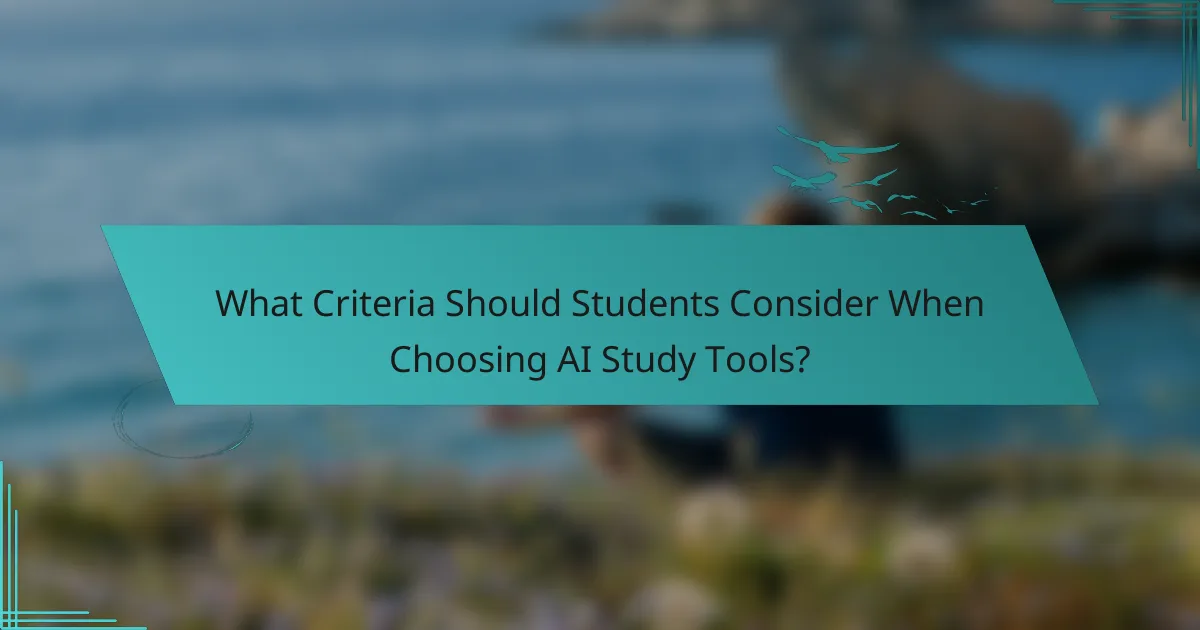
What Criteria Should Students Consider When Choosing AI Study Tools?
Students should consider user-friendliness, content relevance, and cost-effectiveness when selecting AI study tools. These criteria ensure that the tools enhance learning without causing frustration or financial strain.
User-Friendliness
User-friendliness is crucial for effective learning. A tool that is easy to navigate allows students to focus on studying rather than struggling with technology. Look for interfaces that are intuitive and require minimal training.
Consider tools that offer tutorials or customer support. A user-friendly AI study tool should provide clear instructions and responsive help to assist students when they encounter challenges.
Content Relevance
Content relevance ensures that the study material aligns with the curriculum and learning objectives. Students should choose AI tools that offer personalized content tailored to their specific subjects and learning levels.
Check if the tool adapts to the student’s progress and preferences. Tools that provide quizzes, practice tests, and interactive lessons based on the curriculum can significantly enhance understanding and retention.
Cost-Effectiveness
Cost-effectiveness is an important factor, especially for high school students and their families. Many AI study tools offer free versions or trial periods, allowing students to assess their value before committing financially.
Compare subscription costs and features. Some tools may charge monthly fees, while others offer one-time purchases. Look for discounts for students or educational institutions to maximize savings.

What Are the Challenges of Implementing AI Study Tools?
Implementing AI study tools presents several challenges that can hinder their effectiveness for high school students. Key issues include access to technology, data privacy concerns, and the learning curve associated with new systems.
Access to Technology
Access to technology is a significant barrier for many students. Not all students have reliable internet connections or devices like laptops or tablets, which are essential for utilizing AI study tools effectively. Schools must assess their resources and consider providing devices or internet access to ensure equitable opportunities for all students.
Moreover, schools in underserved areas may face additional challenges, such as limited funding for technology upgrades. Collaborating with local businesses or community organizations can help bridge these gaps and enhance access to necessary tools.
Data Privacy Concerns
Data privacy is a critical issue when implementing AI study tools, as these platforms often collect personal information from students. Schools must ensure compliance with regulations like the Family Educational Rights and Privacy Act (FERPA) in the U.S., which protects student education records. Transparency about data usage and storage is essential to build trust with students and parents.
Additionally, selecting AI tools that prioritize data security and have clear privacy policies can mitigate risks. Schools should conduct thorough evaluations of any platform’s data handling practices before adoption.
Learning Curve
The learning curve associated with AI study tools can be steep for both students and educators. Students may need time to adapt to new interfaces and functionalities, which can initially disrupt their study habits. Providing training sessions and ongoing support can help ease this transition.
Educators also require training to effectively integrate these tools into their teaching methods. Schools should allocate time for professional development to ensure that teachers are comfortable using AI tools and can guide students effectively.
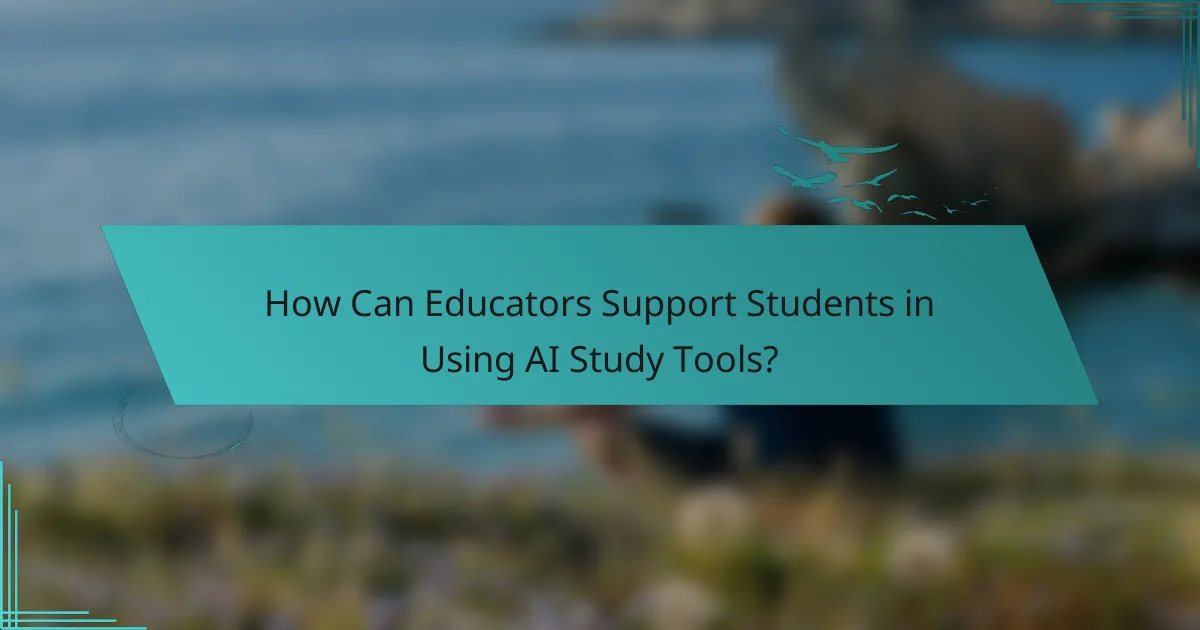
How Can Educators Support Students in Using AI Study Tools?
Educators can effectively support students in utilizing AI study tools by integrating these technologies into their teaching strategies and providing guidance on their use. This involves training students on how to leverage AI for personalized learning and ensuring they understand the benefits and limitations of these tools.
Training Students on AI Tool Usage
Training is essential for students to maximize the benefits of AI study tools. Educators should conduct workshops or classes that demonstrate how to use these tools effectively, focusing on features like personalized quizzes, study schedules, and feedback mechanisms. Hands-on practice can help students become comfortable with the technology.
Additionally, educators can create instructional materials, such as video tutorials or user guides, that students can refer to as needed. This ensures that students have a resource to turn to when they encounter challenges while using AI tools.
Encouraging Responsible Use
Encouraging responsible use of AI study tools is crucial for maintaining academic integrity. Educators should discuss the importance of using these tools as a supplement to traditional study methods rather than a replacement. This helps students develop critical thinking and problem-solving skills.
To promote responsible use, educators can establish guidelines on how to incorporate AI tools into their study routines. For example, students might be encouraged to use AI-generated summaries as a starting point for their own notes, rather than copying them verbatim.
Monitoring Progress and Providing Feedback
Monitoring student progress when using AI study tools allows educators to provide tailored feedback. By analyzing data from these tools, teachers can identify areas where students excel or struggle, enabling them to adjust their teaching strategies accordingly. Regular check-ins can help reinforce learning objectives.
Educators can also encourage students to reflect on their learning experiences with AI tools. This can be done through discussions or written reflections, helping students articulate what strategies worked best for them and how they can improve their study habits.
Integrating AI Tools into Curriculum
Integrating AI study tools into the curriculum can enhance engagement and learning outcomes. Educators should select tools that align with their educational goals and the specific needs of their students. For instance, using AI tools that adapt to different learning styles can cater to a diverse classroom.
It’s beneficial to pilot these tools in a few classes before full implementation. Gathering feedback from students during the pilot phase can provide insights into their effectiveness and help refine the approach for broader use.
